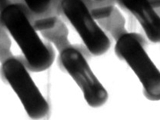Backplane X-ray Analysis
|
This is one of those things that drive people in this business mad. A very expensive and difficult board was manufactured successfully. All the electronic and environmental testing was completed, and the board went into service. Months later, the board began to perform erratically in the field.
Of course, the failure was "high visibility," and everyone was under the gun to find out how and why this was happening. And fix it! The customer urgently directed all possible resources to bear and, after a week or so of testing, found the source of this very sneaky problem.

|
|
|
Figure 1: The lead and plated hole center-bottom has insufficient solder fill.
|
They discovered a dual challenge: a very thick board and leads that were (on occasion) contaminated - most likely oxidized. There was only one component type involved, and this component was placed at about a dozen locations per board, and not every component demonstrated the problem.
At the affected holes on the through-hole component, barrels were incompletely filled with solder, which caused the solder connection with the component lead to occasionally fail after the board had been in the field working for some time.
When the boards arrived at Circuit Technology Center, our challenge was first to identify the holes that were inadequately filled and fill them. At the same time, the customer wanted to ensure that all pins on the problem part were reflowed to ensure they would forevermore demonstrate proper wetting.
Once this was complete, there had to be proof that the holes were filled to everyone's satisfaction. To complicate matters, these boards were covered with a thick conformal coat.
The rather large board was placed, solder side up, at about a 30-degree angle to the x-ray emitter head, in order to permit a full view of the barrel length. Once the board was under view, each location was photographed, and a marker was placed on the photo noting the holes that were clearly underfilled.
Figure 1 is an example of an X-ray snapshot of a plated hole and leads with insufficient solder.
Now came the hard part. It's easy enough to talk about reflowing ground plan pins on a .150-inch thick conformal-coated board, but to actually do it? In order to accomplish this task without damaging non-affected areas, the board had to be prepared by placing thermal-resistant tapes and heat-deflecting material on the surrounding surface areas and components to protect the unaffected components and the solder side conformal coating.
A vacuum desoldering tool was used to remove the conformal coating from the solder-side leads to permit flow and fill at those locations. The interesting thing is that this rework was going to be performed on a BGA rework machine in order to maintain the board at a steady-state high temperature using the BGA rework machine's bottom heater plates to warm the whole substrate and the topside air nozzle to drive heat into the specific rework location.
In order to maintain control of this volume of heat, thermocouples were placed under the rework locations. Thermocouples were also placed to monitor the heating of sensitive devices near the rework area.
The board was slowly heated until the proper base temperature was reached, and then a vacuum de-soldering iron was used to suction out the existing solder, ridding the barrel of any suspect material.
The final step of the soldering phase was to add solder to the target barrels using the soldering iron and wire solder. This process was repeated until all affected plated through holes were properly filled.
The board was cleaned in a de-ionized water washer. Once again, the board was x-rayed at every location.
The rework environment was hot and demanded great patience and skill from the technicians involved. It ain't always easy, but somebody's got to do it.
Several members of the Circuit Technology Center team contributed to this feature story.
|
|
|
|
|